EV Pusher Project - Page Six
EV Pusher Project
Archive Page Six
I've received a few e-mail messages asking what I've been doing on the trailer since the SolWest trip, and the answer is a whole bunch and nothing at all. After getting the EV running again, I made one trip to my client's in Lebanon, which turned out to be the pusher's last trip. As usual, the engine attempted to jettison fairly important parts, like the alternator, by shearing off the bolts holding accessories to the engine block. In fact, I wouldn't have made it another 30 miles further down the road from my breakdown in Mitchell because the alternator had done it again.
At any rate, the next few times I took the pusher out around town, it overheated immediately and totally. Thinking that the problem might be lack of airflow to the radiator, I fabricated an airfoil for the back of the EV to direct air into the pusher's grille. No luck, it still was unusable on the highway. Clearly, it was time to get the new engine rebuilt and installed.
There was one more event that I wanted to show the pusher at, the 2001 NEDRA (National Electric Drag Racing Association) meet held at Woodburn, Oregon on August 25th. Some of the folks I have met online would be there, and I thought that this would be another good forum for exhibiting the pusher. I sent E-mails to J.B. Straubel, the originator of the pusher prototype, suggesting that we could caravan our pushers up the valley to the meet. If one pusher turns heads, imagine what two would do.
As it turned out, the overheating problem was too much to correct, and I ended up towing the pusher to the racing event behind my ICE pickup truck.
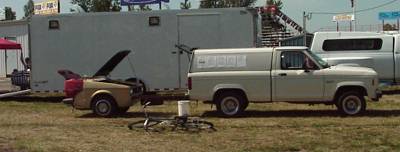
The truck did make a convenient easel for the descriptive literature that I prepared, but I really missed the overhead canopy that I had at SolWest, as it was a very hot summer day, and there was no shade at the track at all. I showed the trailer to about a hundred people, some from the ICE-powered racing cars in attendance, and even managed to meet the new owners of J.B.'s original air-cooled pusher trailer. Five new world records were set this day, including one by an electric go-kart that finished the ? mile at 102 MPH!
The racing was over, and awards presented by 4:30 PM, and I towed the pusher the rest of the way up to Portland to visit friends, and make a transaction to sell one of my Electrak electric tractors to a fellow I met at SolWest.
Upon returning home, I striped the engine block of the 1.6 liter wrecking yard engine, and prepared it to go to the machine shop to be bored and honed. I also took the automatic transmission to a local shop whose owner is construction a hydrogen-powered pickup truck.
 August 30th. Time had come to say goodbye to the old 1.5 liter engine. It's useful life was over, and I wanted to get it out of the engine compartment so that I could clean, paint, and prepare for the new power plant. With the aid of some timbers to help support the weight of the combined engine and transmission, I winched the old equipment out into the open, and began the degreasing procedure, which turned into a multi-day operation using cleaning solvent, scrubbers, a high pressure washer, two pairs of protective gloves, and lots of patience. This isn't even considering the thick, caked-on grease on the underside of the pusher's former floorboards. I spent two days on my back scraping and scrubbing that mess in addition to the engine compartment.
August 30th. Time had come to say goodbye to the old 1.5 liter engine. It's useful life was over, and I wanted to get it out of the engine compartment so that I could clean, paint, and prepare for the new power plant. With the aid of some timbers to help support the weight of the combined engine and transmission, I winched the old equipment out into the open, and began the degreasing procedure, which turned into a multi-day operation using cleaning solvent, scrubbers, a high pressure washer, two pairs of protective gloves, and lots of patience. This isn't even considering the thick, caked-on grease on the underside of the pusher's former floorboards. I spent two days on my back scraping and scrubbing that mess in addition to the engine compartment.
After the grease mess was sufficiently eliminated, I began cleaning engine parts and accessories that would be needed on the new engine, and applying paint to exposed metal. All of the fasteners were cleaned, and I separated various parts in boxes and bins according to their function on the engine.
Sept. 11th. We all know what happened on this day. I spent the time listening to news reports on a walkman stereo and finishing up the project of the previous few days, replacing the Pusher's original steering rack with a rigid substitute that still allows toe-in/toe-out adjustments.
This is about the last work that was performed on the trailer for several weeks. I called the machine shop on Sept. 14th to find out if my new engine was finished and was told that it would be two weeks more before they even began working on it. Made some calls to find out if there was another qualified shop that could do a VW diesel, and was told that I'd be better off just waiting for my engine to be done where it was already.
October 1st. This morning I decided to change tactics on the machine shop, and called them up to announce that I'd be picking up my engine on Friday, and if it was done, that would be good. If it was not done, I'd pick it up anyway and take it to another shop to be machined. Either I got lucky, or this kicked them into gear, as they called on Thursday to let me know it was ready to get. Of course, my position was partially a bluff, as I was spending the latter part of that week at a friend's beach house, and wouldn't be home in time to pick up the block anyway.
 Oct. 8th. Went to the machine shop and got my engine, crankshaft, piston rods, and the new bearings, pistons and rings. The bill was $450. I asked them if this included my discount for allowing them make it a back-burner project for the last six weeks. "Oh sure" was the reply. Took the parts home and got to work masking the block for painting and sprayed it so I could begin reassembly. Yeah, I know, it's orange. Wait until I show you what I have in store for Halloween!
Oct. 8th. Went to the machine shop and got my engine, crankshaft, piston rods, and the new bearings, pistons and rings. The bill was $450. I asked them if this included my discount for allowing them make it a back-burner project for the last six weeks. "Oh sure" was the reply. Took the parts home and got to work masking the block for painting and sprayed it so I could begin reassembly. Yeah, I know, it's orange. Wait until I show you what I have in store for Halloween!
 Jump ahead ten days... Oct 18th. Here's the engine, mostly assembled, with the automatic transmission installed. All of the big items that could have killed this project went just fine. I did have some reservations about attaching an automatic transmission to an engine that was manufactured and installed in a car with a manual transmission, but it looks like the engineers at the "Peoples Car" factory made it all fit together regardless of year of manufacture or model/accessory/option package that the cars were offered with. For that matter, this diesel engine is out of an '82Jetta, and the transmission is out of a late 70's Rabbit with a gasoline motor. It all just bolted up as though it had been meant to be installed in the same car. For now, I'm leaving the easily-installed parts of the motor off, such as the water pump, front pulleys, alternator, oil filter, etc, as that means there is that much less hanging off of the engine to get tangled up or knocked off while installing it in the engine compartment of the Pusher. Note the chrome valve cover!!!
Jump ahead ten days... Oct 18th. Here's the engine, mostly assembled, with the automatic transmission installed. All of the big items that could have killed this project went just fine. I did have some reservations about attaching an automatic transmission to an engine that was manufactured and installed in a car with a manual transmission, but it looks like the engineers at the "Peoples Car" factory made it all fit together regardless of year of manufacture or model/accessory/option package that the cars were offered with. For that matter, this diesel engine is out of an '82Jetta, and the transmission is out of a late 70's Rabbit with a gasoline motor. It all just bolted up as though it had been meant to be installed in the same car. For now, I'm leaving the easily-installed parts of the motor off, such as the water pump, front pulleys, alternator, oil filter, etc, as that means there is that much less hanging off of the engine to get tangled up or knocked off while installing it in the engine compartment of the Pusher. Note the chrome valve cover!!!
As mentioned above, there's a little Halloween surprise waiting for you here behind the Click-or-Treat link.
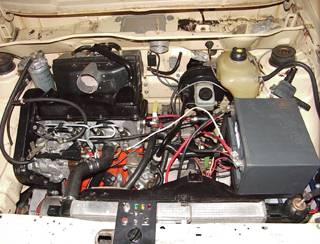 October 28th. A whole bunch of assembly and installation later, the engine is in the car, connected, wired, plumbed and ready to try out. As a precaution, I pre-charged the oil system by running the engine's oil pump using a ½ inch drill motor connected to a socket extension and 13mm socket. Late in the day, I plugged in the block heater, connected the battery and tried to crank the new creation to life. What I got was an unsatisfactory and very labored rotation of the crankshaft. The motor was turning over way too slow to actually start. I connected jumper cables to my electric tractor (heavy-duty, deep discharge golf car batteries), and even put two battery chargers on the system. The engine still turned over too slow for any possibility of starting.
October 28th. A whole bunch of assembly and installation later, the engine is in the car, connected, wired, plumbed and ready to try out. As a precaution, I pre-charged the oil system by running the engine's oil pump using a ½ inch drill motor connected to a socket extension and 13mm socket. Late in the day, I plugged in the block heater, connected the battery and tried to crank the new creation to life. What I got was an unsatisfactory and very labored rotation of the crankshaft. The motor was turning over way too slow to actually start. I connected jumper cables to my electric tractor (heavy-duty, deep discharge golf car batteries), and even put two battery chargers on the system. The engine still turned over too slow for any possibility of starting.
Now one of my fears was being realized. When I installed the starter motor, I noticed that the motor supplied with the automatic transmission was only about 2/3 the size of the starter motor that I had removed from the manual transmission that was on the old 1.5 liter diesel. Given the added compression of diesel engines, it's likely that this starter motor, which came off of a gasoline Rabbit, is too weak to use on the diesel. Converting over to the manual transmission's starter was not possible, as the starters rotate in opposite directions, and have very different mountings. Hmmm, I wonder what would happen if I used 24 volts to run the starter?
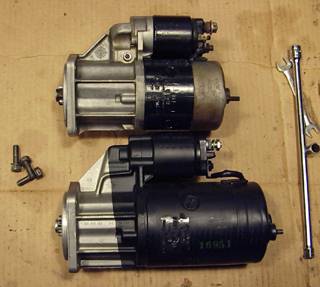 October 30th. A call to the nearby German Auto Service revealed that there is indeed a different starter for the diesel automatic versions of the Rabbit. At $109, I had no choice but to grab my wallet and purchase the correct starter for the engine. Here's the visual proof of the difference in the gas and diesel starter motors for the automatic transmission equipped vehicles.
October 30th. A call to the nearby German Auto Service revealed that there is indeed a different starter for the diesel automatic versions of the Rabbit. At $109, I had no choice but to grab my wallet and purchase the correct starter for the engine. Here's the visual proof of the difference in the gas and diesel starter motors for the automatic transmission equipped vehicles.
Back at home, and again very late, I installed the starter and fired up the block heater. Heating the glow plugs manually for 15 seconds, then hitting the starter button brought the new engine immediately to life. I let it run for a couple of minutes, then noticed that I had some fairly significant fuel leaks at the tops of two of the injectors, and some bubbles appearing at the base of the same two injectors, indicating compression loss. Shut the engine down to mop up the spilled Biodiesel and tighten the connections. As the hour was near dinner, I decided that this would be enough for one day, and turned off the shed lights and put away my tools.
More nasty financial surprises await. I need a new alternator and a glow plug relay. This new engine has the "fast" glow plugs, and the old engine and relay were of the "slow" variety. One day soon, I'll have to total up the cost of this project.....
November 2, 2001. Today I checked out the injectors, reinstalled them in the cylinder head and retorqued them to specification. Upon starting the engine, I still had some leaks around where the injectors enter the head, but I was able to tighten the injector supply line up enough to stem the flow of fuel. Also noticed some engine oil escaping the valve cover gasket, which I corrected by torqueing the cover to factory specs. Let the engine run up to temperature, which was about the time the radiator fan came on automatically. About the same time, the leaks around the injectors stopped, so there must be some sealing of the heat shields that requires heat.
Keeping busy later, I installed the cables from the injection pump throttle lever to the transmission, and from the transmission to the area where the control servo will be mounted. This transmission uses throttle position to modulate the transmission function for shifting, etc, so the accelerator cable "runs through" the transmission on it's was to the injection pump.
Nov 3rd. Decided it was time to try applying power to the wheels, so attached the Pusher to the EV to keep it from running away, then started the engine. Putting the transmission into "Drive" had no effect, and neither did "Reverse", even when the engine was revved up. Great, more trouble. First thing to check was the transmission fluid level, which didn't even show on the end of the dipstick. ????? The transmission had fluid in it when I checked it before I installed it, but I guess that got slurped up by the pump and distributed to someplace that had a pocket of air. Obviously, I'll need to fill it up before I try again. Just hope that no damage was done by the lack of lubrication when I was running it for an extended period yesterday.
The rest of this sunny Fall day was spent installing the control cable from the former floor shifter that selects the transmission range, and making plans to mount that shifter in the 'trunk' are of the trailer. Also considered my options for replacing the RC servo of the throttle with something heftier. The new transmission/kickdown lever/injection pump combination requires along the lines of 25 pounds of pull to actuate, and the RC servo won't come close to that much torque. I'm making plans to use the former windshield wiper motor and gearbox to build my own servo assembly, controlled by the electronics that the old servo used.
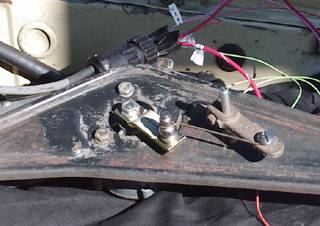
Nov 7th. Barely any time this morning to work on the trailer, but I did cobble together a test jig using the old windshield wiper motor and part of it's bracket. Mounted a 5k linear potentiometer and linked it to the bell crank of the gearbox using a stiff piece of wire and a silicon-bronze lever off of a large gasoline generator carburetor. I soldered some temporary wires and connector pins and plugged it all into the car's servo connector. It Works! The motor is pretty slow, as it's still running on the 6 volt regulated output for the old RC model servo. I'll have to rewire that to supply 12 volts to make this more powerful, but the basic idea is going to work fine.
After wasting part of the afternoon out making money, I purchased some accelerator system hardware to fashion a more permanent link for the position sensing pot, and I'm already figuring out how I'll mount the motor and gearbox, and interface it with the accelerator cable to the transmission. Tomorrow I have some sheet metal to pick up and I'll stop by the recycle yard to look for some small cable pulleys in the junk bicycle parts shed.
Nov 10th. Today, I found out that I don't have the only pusher in town. While loading my tools into a company van, I heard an unmuffled small engine and looked up in time to catch an amazing sight, a wheelchair hauling down West 11th. Street with what looked like the back half of a Go-Kart pushing it along. No lights, on number plate, no fenders, no helmet, just a guy doing maybe 30 MPH in a wheelchair in the right hand lane, right along with traffic!!!
No details about how he controls the engine or steers. I did look out for him when I followed along the same street several minutes later, but no sign of him. Josh, of Eugene BioSource said that he had seen this vehicle (?) a few days earlier. I'd love to have my camera handy and run into him somewhere before the cops nab him.
Nov 18th. A week +plus+ of regressive progress. Cleaned up the under-hood wiring, and made some of the temporary connections permanent, wired up a cut-out switch on the throttle to shut down the LPG fumigation when the engine is idling, and worked inside the controller to interlock the LPG to the oil pressure light. No oil pressure = no LPG. A pretty simple way to make sure I don't end up pumping propane into an engine that is not running.
Spent some time putting the windshield wiper motor into an enclosure and fabricating linkage to the position pot. Ordered a chain and sprocket set for the throttle cable to connect to, and created a wiring cable to connect the new servo to the controller.
When I got ready to change over to the new servo, I tried the old one to make sure that it still worked. It didn't. Removed the controller from the car and poked around inside it for a while, looking for problems. Of course I found problems unrelated to the servo not working. Like having a surface-mount transistor fairly jump off of the circuit board during desoldering and disappear into the carpet, never to be seen again. Crumbs. Spent most of last night on the Internet, looking for H-bridge circuits to replace the one in the controller, as I didn't think I could salvage it without the lost part. At this point, I have removed some more of the infinitesimally small components and drilled tiny holes in the circuit board to allow me to install standard top-mount parts to get the circuit working again (I hope). At least the time on the 'net allowed me to figure out how this circuit works, which means that I can redesign parts of it to work at 12 volts to run the new, larger servo motor at full voltage, instead of the 6 volts that the old servo motor was limited to. Of course, the controller is shredded up into tiny pieces and must be rebuilt and reassembled before I can even test to see if the servo driver chip is toasted. I did open up two other servos to see what was inside and I can use their guts if I have to.
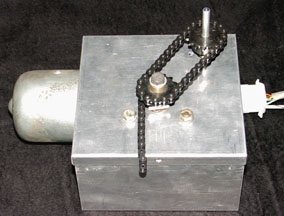 November 26th. They say that the "Devil is in the Details", and I'm just one small sub-system from being able to try out the Pusher with it's new engine and modern automatic transmission, and that is the Dad-Ratted throttle servo. Things are getting close, though. For a good while, I was trying to find some small roller chain and sprockets, and was pretty sure I could scavenge up something from my junk collection or around the radio station's inventory of old equipment. Nothing I found was very promising, so I went ahead and bought some ¼" pitch #25 chain and two of the smaller sprockets I could order. My original design to open the throttle and depress the kick-down lever on the transmission using a half-turn of the servo shaft fell short of perfection, so I redesigned the position sensor linkage to use more chain and sprockets instead of the windshield wiper ball-and-socket linkage. Now I just have to wait for the last 14 tooth sprocket to arrive from Portland, and put it all together. Getting the sprocket to engage the shaft of the windshield wiper motor gearbox required some machining and careful design considerations.
November 26th. They say that the "Devil is in the Details", and I'm just one small sub-system from being able to try out the Pusher with it's new engine and modern automatic transmission, and that is the Dad-Ratted throttle servo. Things are getting close, though. For a good while, I was trying to find some small roller chain and sprockets, and was pretty sure I could scavenge up something from my junk collection or around the radio station's inventory of old equipment. Nothing I found was very promising, so I went ahead and bought some ¼" pitch #25 chain and two of the smaller sprockets I could order. My original design to open the throttle and depress the kick-down lever on the transmission using a half-turn of the servo shaft fell short of perfection, so I redesigned the position sensor linkage to use more chain and sprockets instead of the windshield wiper ball-and-socket linkage. Now I just have to wait for the last 14 tooth sprocket to arrive from Portland, and put it all together. Getting the sprocket to engage the shaft of the windshield wiper motor gearbox required some machining and careful design considerations.
Also a factor in the slowness of this phase of the rebuild was converting the RC servo controller circuit board to use a 12 volt motor, instead of the 6 volt that it was intended to serve. I haven't done a dynamic test, but it should work out alright. Once I have the servo motor finished, I'll be able to try it out. I'm also designing a "park" feature that returns the throttle to the idle position when the ignition to the engine is cut. This motor and gearbox uses a worm gear arrangement, and the throttle spring can't pull it back when the power is off.
Original material ©1996-2025 Mr. Sharkey | All rights reserved
